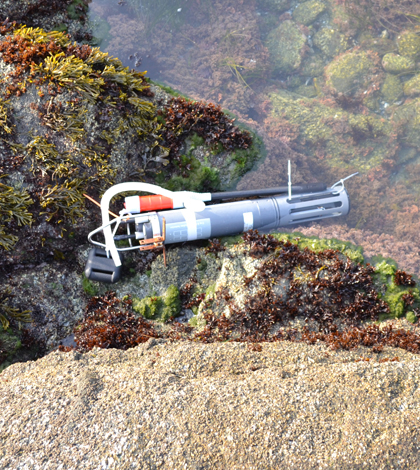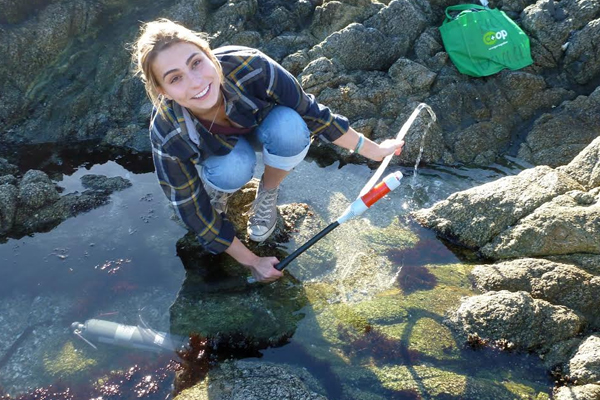For California Tide Pools, Nighttime Brings Acidic Conditions

Sampling pump and a device to measure temperature, salinity and depth in a tide pool of the Bodega Marine Reserve. (Credit: Lester Kwiatkowski / Carnegie Institution for Science)
A lot of things that occur in nature can be considered scary. Forest fires, earthquakes and volcanic eruptions all seem to be good examples. But what about darkness? For some calcifying organisms living in coastal tide pools, darkness can be downright terrifying.
That’s because of the impacts that nightfall has on the plants living around them, according to research led by scientists at the Carnegie Institution for Science. When night falls, these plants begin respiring, instead of relying on photosynthesis for energy, which can greatly impact the carbon dioxide levels in surrounding seawater.
In their investigation, Carnegie researchers joined with others at the University of California, Davis, to instrument four coastal tide pools at the Bodega Marine Reserve. Measurements of conductivity, temperature and depth were gathered using YSI 6600 water quality sondes, while pumps were used to collect discrete water samples for analysis back in the lab.
Scientists considered the depths, volumes and community structures of each pool they encountered. The dominant calcifying organisms in all of the pools were coralline algae and crustose coralline algae, but also found were bivalve mollusks and creatures that have shells, like snails.

Study co-author Yana Nebuchina preparing to sample from a tide pool on the Bodega Marine Reserve. (Credit: Ken Caldeira / Carnegie Institution for Science)
The seawater chemistry and its changes were tracked during mostly the early summer months (April, May and June) of 2014 and 2015 on hourly timescales during five visits to the pools at low tide, when they are isolated from the open ocean. The sampling periods in 2014 took place during the daytime and those occurring in 2015 were carried out at night.
The data showed that conditions in the tide pools got better for calcifying organisms during the day. But through the night time, plant respiration influenced the seawater’s pH enough to make the pools dangerously acidic for the creatures. The rates at which the organisms’ shells dissolved were increased by the nighttime changes, researchers found.
“This work highlights that even in today’s temperate coastal oceans, calcifying species, such as mussels and coralline algae, can dissolve during the night due to the more-acidic conditions caused by community respiration,” said Lester Kwiatkowski, a research scientist at Carnegie and the study’s lead author, in a statement.
While scientists didn’t assess how photosynthesizing calcifiers, like calcifying algae, did on an individual basis, they think that their findings overall will help predictions in the future relating to daytime calcification on community scales.
As for the implications of their nighttime findings, researchers are concerned that the acidification rates they documented in the California tide pools serve as an early indicator of things to come if acidification continues elsewhere. Making that assumption, they estimate that there could be twice as much nighttime dissolution by 2050 with current trends.
Full results of their investigation are published under open-access license in the journal Nature: Scientific Reports.
Top image: Sampling pump and a device to measure temperature, salinity and depth in a tide pool of the Bodega Marine Reserve. (Credit: Lester Kwiatkowski / Carnegie Institution for Science)





0 comments